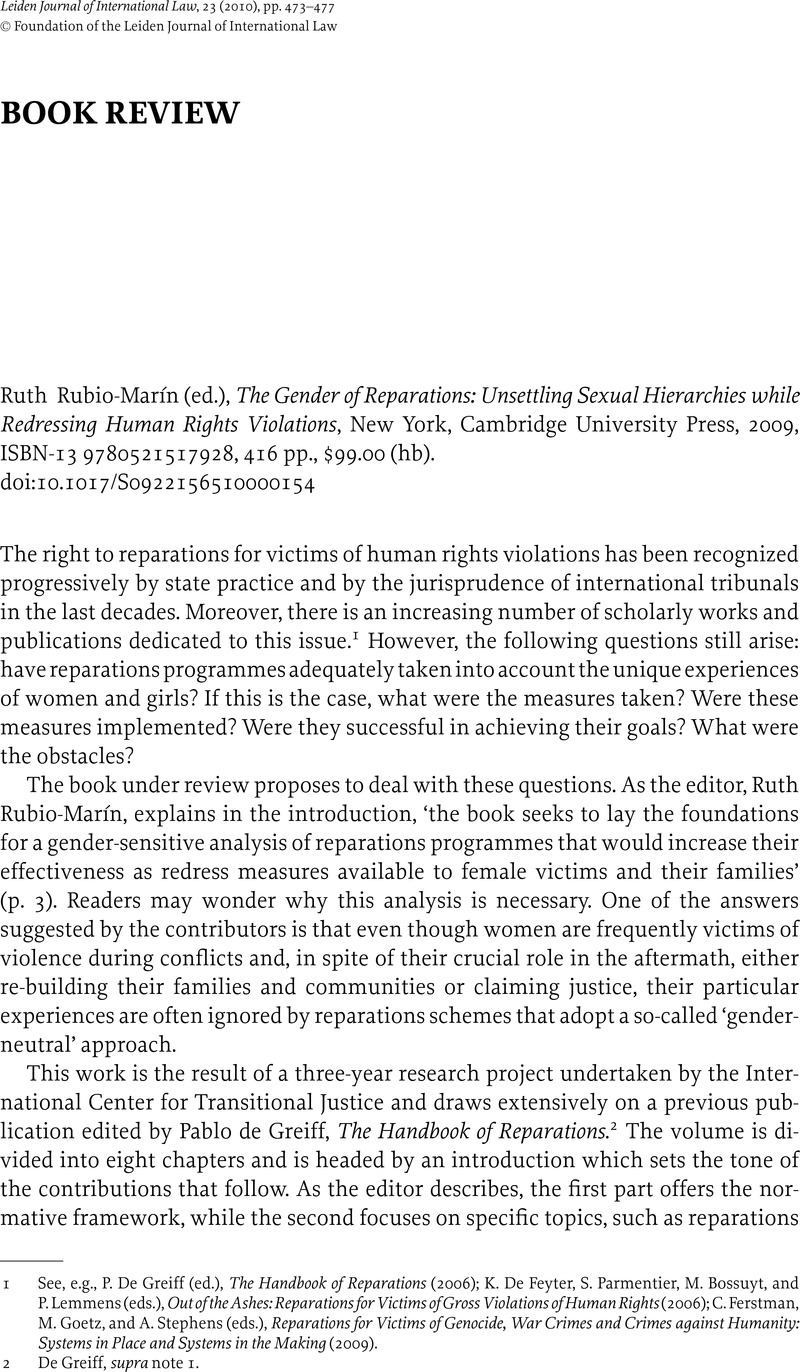No CrossRef data available.
Article contents
Ruth Rubio-Marín (ed.), The Gender of Reparations: Unsettling Sexual Hierarchies while Redressing Human Rights Violations, New York, Cambridge University Press, 2009, ISBN-13 9780521517928, 416 pp., $99.00 (hb).
Review products
Published online by Cambridge University Press: 27 April 2010
Abstract

- Type
- BOOK REVIEW
- Information
- Copyright
- Copyright © Foundation of the Leiden Journal of International Law 2010
References
1 See, e.g., P. De Greiff (ed.), The Handbook of Reparations (2006); K. De Feyter, S. Parmentier, M. Bossuyt, and P. Lemmens (eds.), Out of the Ashes: Reparations for Victims of Gross Violations of Human Rights (2006); C. Ferstman, M. Goetz, and A. Stephens (eds.), Reparations for Victims of Genocide, War Crimes and Crimes against Humanity: Systems in Place and Systems in the Making (2009).
2 De Greiff, supra note 1.
3 The chapter also includes a study of the practice of states which have adopted reparations programmes, such as Argentina, Chile, South Africa, Peru, Guatemala, and Sierra Leone.
4 Notwithstanding, the authors mention Aloeboetoe v. Suriname, where the Inter-American Court referred to the domestic law, the traditional Saramaka custom of awarding reparations to successors, but asserted that it did not make any distinctions between men and women, even though contrary to Saramaka custom, seeking to balance respect for cultural values with the right of women not to be discriminated against on the grounds of their sex. It is worth noting that in the recent case Pérez Torres et al. v. Mexico (‘Campo Algodonero’), Judgment of 16 November 2009, Series C No. 207 (in Spanish only), the representatives of the victims referred to the crimes committed in Ciudad de Juarez against women as a ‘feminicide’, but the Court chose to use the term ‘homicide of women for gender reasons’ instead, while acknowledging that the expression is also known as ‘feminicide’ (para. 143). The Court adopted a gender approach for the reparations which included different types of measures, stating, inter alia, that the Mexican state had a duty to investigate the murders and disappearances of women from a gender perspective (para. 455(ii)), deciding that the date 6 November should be commemorated as the ‘National Day in memory of the victims of the feminicide’ (para. 466), and holding that the state had the obligation to build a memorial for women victims of homicide for gender reasons in the field where the victims were found, after a public and open consultation with civil society organizations, including those representing the victims in the case (paras. 471–472).
5 It is interesting to note the case of the Parque de la Memoria, located in Buenos Aires, Argentina. Following the concept of a wall of names, often used in these cases, it includes the names of the victims of the last military dictatorship. However, it presents a unique feature: the word embarazada (pregnant) was added next to the names of the women who were carrying a baby at the time of their abduction, thus reflecting the particularities of women's experience.
6 Even if the UN Basic Principles and Guideline on the Right to a Remedy and Reparations for Victims of Gross Violations of International Human Rights Law and International Humanitarian Law (UN Doc. A/RES/60/147 (2006)) include the principle of non-discrimination, they have adopted a gender-neutral approach. Therefore it is important to complement this instrument with the Nairobi Declaration on Women's and Girls’ Right to a Remedy and Reparations, adopted in March 2007, which specifically adopts this transformative notion of reparations.


